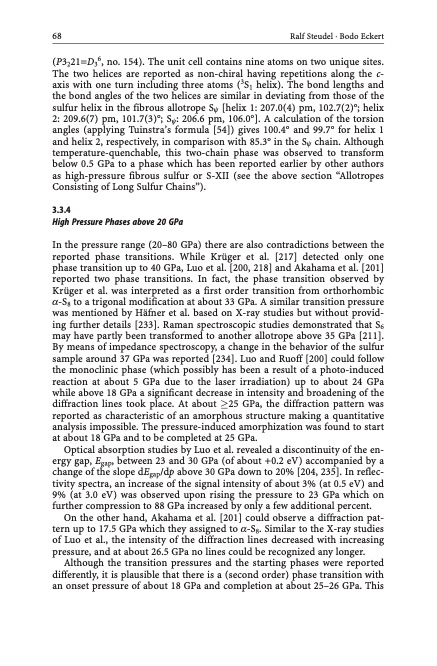
PDF Publication Title:
Text from PDF Page: 078
68 Ralf Steudel · Bodo Eckert (P3221=D36, no. 154). The unit cell contains nine atoms on two unique sites. The two helices are reported as non-chiral having repetitions along the c- axis with one turn including three atoms (3S1 helix). The bond lengths and the bond angles of the two helices are similar in deviating from those of the sulfur helix in the fibrous allotrope Sy [helix 1: 207.0(4) pm, 102.7(2); helix 2: 209.6(7) pm, 101.7(3); Sy: 206.6 pm, 106.0]. A calculation of the torsion angles (applying Tuinstras formula [54]) gives 100.4 and 99.7 for helix 1 and helix 2, respectively, in comparison with 85.3 in the Sy chain. Although temperature-quenchable, this two-chain phase was observed to transform below 0.5 GPa to a phase which has been reported earlier by other authors as high-pressure fibrous sulfur or S-XII (see the above section “Allotropes Consisting of Long Sulfur Chains”). 3.3.4 High Pressure Phases above 20 GPa In the pressure range (20–80 GPa) there are also contradictions between the reported phase transitions. While Krüger et al. [217] detected only one phase transition up to 40 GPa, Luo et al. [200, 218] and Akahama et al. [201] reported two phase transitions. In fact, the phase transition observed by Krüger et al. was interpreted as a first order transition from orthorhombic a-S8 to a trigonal modification at about 33 GPa. A similar transition pressure was mentioned by Häfner et al. based on X-ray studies but without provid- ing further details [233]. Raman spectroscopic studies demonstrated that S6 may have partly been transformed to another allotrope above 35 GPa [211]. By means of impedance spectroscopy, a change in the behavior of the sulfur sample around 37 GPa was reported [234]. Luo and Ruoff [200] could follow the monoclinic phase (which possibly has been a result of a photo-induced reaction at about 5 GPa due to the laser irradiation) up to about 24 GPa while above 18 GPa a significant decrease in intensity and broadening of the diffraction lines took place. At about 25 GPa, the diffraction pattern was reported as characteristic of an amorphous structure making a quantitative analysis impossible. The pressure-induced amorphization was found to start at about 18 GPa and to be completed at 25 GPa. Optical absorption studies by Luo et al. revealed a discontinuity of the en- ergy gap, Egap, between 23 and 30 GPa (of about +0.2 eV) accompanied by a change of the slope dEgap/dp above 30 GPa down to 20% [204, 235]. In reflec- tivity spectra, an increase of the signal intensity of about 3% (at 0.5 eV) and 9% (at 3.0 eV) was observed upon rising the pressure to 23 GPa which on further compression to 88 GPa increased by only a few additional percent. On the other hand, Akahama et al. [201] could observe a diffraction pat- tern up to 17.5 GPa which they assigned to a-S8. Similar to the X-ray studies of Luo et al., the intensity of the diffraction lines decreased with increasing pressure, and at about 26.5 GPa no lines could be recognized any longer. Although the transition pressures and the starting phases were reported differently, it is plausible that there is a (second order) phase transition with an onset pressure of about 18 GPa and completion at about 25–26 GPa. ThisPDF Image | Topics in Current Chemistry

PDF Search Title:
Topics in Current ChemistryOriginal File Name Searched:
Elemental-Sulfur-und-Sulfur-Rich-Compounds-I.pdfDIY PDF Search: Google It | Yahoo | Bing
Sulfur Deposition on Carbon Nanofibers using Supercritical CO2 Sulfur Deposition on Carbon Nanofibers using Supercritical CO2. Gamma sulfur also known as mother of pearl sulfur and nacreous sulfur... More Info
CO2 Organic Rankine Cycle Experimenter Platform The supercritical CO2 phase change system is both a heat pump and organic rankine cycle which can be used for those purposes and as a supercritical extractor for advanced subcritical and supercritical extraction technology. Uses include producing nanoparticles, precious metal CO2 extraction, lithium battery recycling, and other applications... More Info
| CONTACT TEL: 608-238-6001 Email: greg@infinityturbine.com | RSS | AMP |